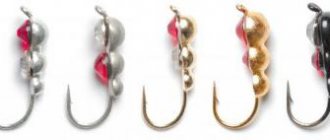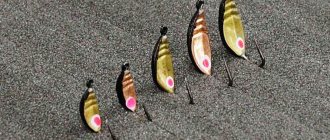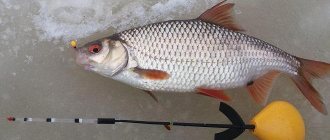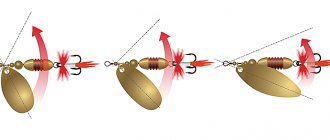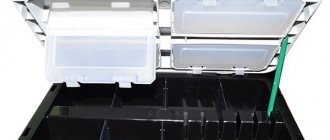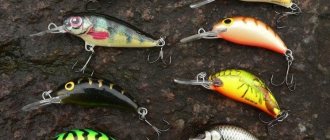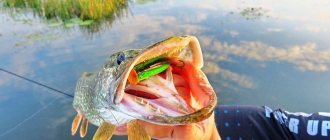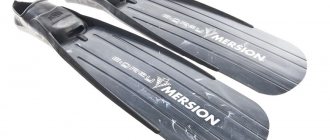Perch has become one of the main objects of amateur fishing from the very beginning of the formation of ice. Due to its abundance, perch on the first ice turns fishing into a real holiday for novice anglers. The success of fishing in this case is determined by the correct choice of place, gear, technique and fishing tactics.
Where to fish and how to find fish
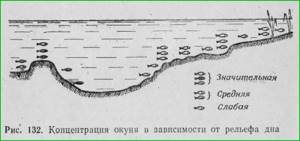
In the first ice, finding perch at the bottom of the reservoir is very difficult. As already noted above, in the first ice this fish likes to swim not deep and close to the shore in order to feed on vegetation, such as reeds, actively stocking up on fat for further wintering.
It is during the first ice that there is a great prospect of catching large predators, because all the fish swim along the shores in the hope of finding food.
Where to catch perch on the first ice? For a rich, long-lasting bite of striped fish in the first ice, it is worth choosing larger reservoirs, since on a river or lake the pleasure of searching for and catching perch can be short-lived. It's all about a small amount of oxygen, as a result of which the fish begins to doze off earlier, which cannot be said about large rivers or lakes.
On the first ice, the perch is very energetic and takes almost all available bait. The most important thing is to choose a good place, tackle and the right bait. Approaching the location of the perch catching spot wisely is practically the key to success. When a striped fish appears in one of the points of the reservoir, I would like to see not its random bites on the bait, but a rich fish catch.
Winter fishing is a process that takes a lot of energy. In order not to be left without a catch or with minimal results at the end of your fishing trip, you need to walk a lot. Catching striped fish on the first ice begins with drilling a large number of holes. They start from the shore of the reservoir. The distance from hole to hole directly depends on the fishing technique and the bait that you plan to use.
Perch is not a timid fish. But since the activity of this fish directly depends on sunlight, and the first ice implies thin, transparent ice, the fish can be greatly frightened by the movement of the fisherman’s shadow and the flickering of light, plus, striped ones monitor their safety and are afraid of being eaten by a large pike, therefore When moving on ice, you must remain calm, careful and avoid loud sounds.
How to choose a fishing spot
The first priority is to find the area where the bass are currently feeding.
If you're lucky, you won't have to walk for long; otherwise, fishing is guaranteed. The fish begins to actively move around the reservoir in search of food as soon as the cold weather arrives. Once the water is covered with ice, much depends on the air temperature. If the frost gets stronger and lasts for a long time, then the small fish will go to the depths, and a predator will follow. In case of warming, squirrels begin to visit the shallows. On rivers where there are a lot of perch, the fry are constantly on the move, trying to find shelter.
Therefore, a striped fish can peck anywhere, regardless of the temperature outside. Arriving at the reservoir, you should drill as many holes as possible. This is done in the direction from the shore to the middle of the reservoir, in a checkerboard pattern.
Using this technique, 10 holes with a distance of up to 10 meters between them will be enough. Now you can start fishing, stopping for 5 minutes on each one. Be sure to try different baits and retrieves. Once the bite starts in one of the holes, you shouldn’t hesitate.
It is important to cast the tackle and pull out the caught fish as soon as possible. Perch gather in huge schools, so if you find a cool place, you have a chance to get a good catch in one place. Tip: drill additional holes around the catch point (at a distance of 3 meters), fishing them, thereby increasing efficiency.
Excellent places would be snags, flooded trees, bushes, reeds, reeds and other vegetation. The chance of a tackle breaking in such places increases, but at the same time the effectiveness increases. This is due to the fact that the striped fish is also in the crosshairs of larger predators, such as pike or pike perch.
Therefore, it tries to stay near natural shelters. Small and medium-sized perch swim along the coastline up to ice thicknesses of 20 cm. Large humpback whales spend almost all their time at depth in holes. They go ashore to feed only before sunrise or after sunset. Immediately after sunrise they rush to a safe place - the pits.
How to catch and what to use to catch perch
It has already become a tradition that the main object of fishing on the first ice remains the perch fish. Every angler understands how to catch perch on the first ice.
Let's consider one of the main baits for fishing - winter spinners.
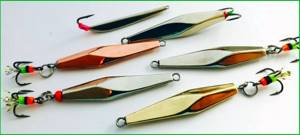
It has been noticed that our striped friends are very active for about 2-3 weeks after the first ice freezes. In small reservoirs with a depth of up to 1.5 - 2 meters, perches can be active for 2-3 days. Perches are constantly moving, in winter they are almost always in groups, and in a school there can be individuals of various sizes.
Without exception, all stripes in the flock energetically catch fry. Perhaps that is why the method of catching fish with a spoon is the richest in catch, because the spoon attracts their attention.
For the purpose of baiting perch, a spinner should preferably be small in size, because the smaller it is, the richer the bite, but at the same time the bite is specifically for a small perch. Also, the choice of spoon size depends on the fishing season. In the first ice it is better to take larger spoons. It is also important to be able to properly handle and play with the lure.
This is much more difficult than operating a jig, but learning how to use it is not difficult and does not take much time. It is necessary to take into account that the game of each spinner is special and it is worth trying to play with the spinner in advance in order to see the game with your own eyes. There are a huge variety of options for catching perch using a spoon in winter, but you need to select at least some options in advance for their further use.
For example:
- Clear sudden upward strokes. At the same time, the spinner should jump a meter and a half. The correct position of the spoon is a few centimeters from the bottom. We quickly lower our hand to its original state so that the spoon falls under its own weight, creating a tempting situation for the perch. Before the next jerk, you must wait from ten to thirty seconds.
- Soft lifting of the spinner. Also, the primary position of the spoon is a few centimeters from the bottom, then it gently, measuredly moves upward, producing minor movements. Every centimeter the spinner accelerates, and we begin to lift it to arm's length. You just need to pause at the top and bottom, after which we send the spoon to its original location on the bottom.
Small, sharp movements of the spinner, where it is maintained for 10-15 seconds, and then rises and falls again. So every 15 seconds.
It is important to know that a pause plays a big role in the lure of a perch, because during such breaks the striped fish bites.
Author's jigs
I’ll tell you about jigs that I invented and made specifically for baitless fishing. In them I tried to realize my ideas about the “correct” game of the bait, and, in my opinion, I succeeded. The process was long: many hours of testing on various bodies of water, adjusting shapes, bends, sizes, colors, tuning, and so on. Today jigs work great and catch any fish. Although the baits were created specifically for fishing without bait, it turned out that even with bloodworms, jigs, and various jig larvae, jigs consistently attract fish with their action. So these ideas turned out to be universal.
"Owl"
The “owl” jig was created as a “search” jig for baitless fishing for perch and pike perch. You can also catch ruffe, roach, whitefish, and spring carp with it. Maybe other fish are caught - I haven’t tried fishing for “owl” in other regions.
The motivation for creating this jig was very simple and obvious: the spoon attracts fish from a large radius around the hole, while the jig has a fish collection radius that is two to three times smaller. Therefore, for successful fishing, you first play in the hole with a spoon, teasing and collecting fish, then quickly lower the jig there and catch. However, when fishing on the go, it takes time to replace fishing rods and, in general, it’s annoying and boring! So I decided to create a bait that collects fish well and at the same time catches it, and not a spinner with a suspended hook or jig, but a full-fledged baitless bait. The modeling and testing process lasted three years... A long time, of course! But now I can use the nozzle-less jig “owl”. She recently became an “owl”, before that she was a “scoop”. But it’s too good and “wise” to catch and collect a predator! Therefore, I “transformed” the jig.
You can make bait from copper, brass, cupronickel, even from a tin can.
The hook to the “wing” of the jig must be well soldered, but without thick filling with tin. This part of the jig should be light and fairly rigid. The main weight in the bait is distributed along the “scoop handle” and the angle of its transition to the plane of the wing. It is important! The wing needs to be given a slight bend, following the rounded shape of the forend. There should be no more solder than is necessary to securely fix the hook.
Paint in your favorite colors and combinations. The colors you see in the photo work well on Gurgan reservoirs. The bottom of the jig is not painted, that is, the natural color of the metal used is preserved.
Tuning is minimal. When playing, the bait has very pronounced body oscillations, as I put it: “a good swing.” Therefore, one medium-sized bead with a cambic lock is quite enough. I use carrot colored beads most often. But I don’t shy away from yellow, white, and black colors.
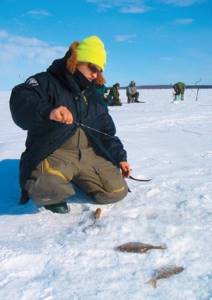
Despite the fact that the “owl” is very similar to a micro spinner, it is still a full-fledged jig with a body size of no more than 15 mm, and trying to catch it like a spinner is not very effective. I play with the jig excitedly and even aggressively - so that the vibrations of the bait can be felt by my fingers. Wiring - fast saw, pendulum, bell. I make vector wiring between them, and bites happen both on the ascent and on the descent! I do the downward release after moving up in quick steps of 3 - 5 cm - very often there are greedy grabs.
In general, the “owl” jig is very catchy and collects fish from a considerable distance. Dip the jig into the jar, throw some of the tea in there and start playing with the jig. You will see how merrily and quickly the tea leaves swirl in the streams and whirlpools of water created by the vibrations of the bait!
At first I used the “owl” as a search bait, and now I often fish with it all day long.
"Whistle"
For Trans-Ural reservoirs, the following sign is true: “The closer spring is, the smaller the jig.” The “owl,” which works perfectly in the first half of winter, begins to malfunction in early February. Attempts to reduce the size of the bait were unsuccessful, since the jigs turned out to be very light and were only suitable for depths of no more than 2 m. In addition, their game was sluggish and chaotic, and any slight breeze turned fishing into torture.
I set myself the task: to create a nozzle-free jig that works stably in the dead of winter and in the spring. After two years of testing and experimentation, we managed to come up with and “bring to fruition” a jig, which we called “whistle” because of its similarity in shape to the well-known sports referee’s whistle.
This is the final search option. Before this, as you understand, there was a long creative process, about which you can write a separate article with dozens of photographs. And how much joy there was when the “whistle” began to catch very worthy fish in the very first field tests! The subsequent “running in” of the new jig showed that it can be successfully fished not only in the dead of winter, but throughout the entire season.
The basis is a tungsten “pellet” with a large hook extension. A brass or cupronickel silver (or silver) petal is soldered to the shank of the hook. It is not difficult to make such a jig, since the “pellet” is easy to find on the shelves of fishing stores, and its price is not high. It’s not difficult to cut out a petal...
The problem arises when trying to solder the petal to the fore-end, since the hook instantly “solders off” from the body of the jig. I tried gluing, clamping, filling with epoxy... but nothing worked. In the end, I found a very simple solution: I clamp the body of the jig together with the hook with tweezers or a surgical clamp and calmly service, solder and file the petal. In addition, during the manufacturing process of the bait, the hook is additionally filled with tin and is held much more tightly in the body of the jig than it was originally.
When playing, the “whistle” has a good “swing”, so tuning the bait is kept to a minimum, or even not used at all. It catches any fish well and with all fishing techniques known to me. Both beginners and experienced fishermen can easily master fishing with this jig. I hope the “whistle” brings you many happy hours of fishing!
Winter fishing with a balance beam
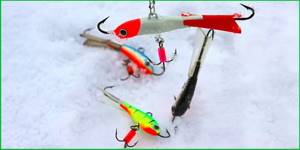
Fishing with a balance beam can also give a good catch. The peculiar “flirting” of the balancer can be so interesting for the perch that it will not be able to resist, although before this it might not have responded to any other tricks. Numerous varieties of balancers in shape and size give the fisherman the opportunity to choose the desired option.
The most convenient way to select a more suitable type of balancer is to be directly on the pond. Because in different reservoirs striped fish have their own “tastes”. When hunting perch using a balance beam, you don’t need to try different variations; simply throwing it up at a distance of 15-30 centimeters is enough, and it starts playing as it falls.
The color is not at all important, it is the play of it that is important, therefore, if necessary, you can simply change the color from bright to dark and this will be quite enough. Also with size.
If the bite is small or not at all, you need to try a balancer of a different shape or size and it will play differently. You need to try several options.
Color
All fishermen have absolutely no agreement on this issue. Some of them prefer jigs of bright colors. They believe that this will help activate the bite. Others respond to this by saying that such bait can scare away fish.
In fact, the reason is that the behavior of the perch directly depends on the reservoir. Therefore, his behavior may be the opposite; it will be very difficult to guess this in advance. To avoid worrying about this, take several different types of jigs with you at once.

They should differ from each other: shape, weight and color. This way you can alternate them and understand which ones are currently showing the best results. If you have a choice in the store, which ones to buy. Take calmer shades, you definitely won’t go wrong. Another color must be chosen depending on the depth, for example:
— If the depth is no more than 1.5 m, you should give preference to silver-dark or other dark colors;
— If the depth is more than 2 m, take gold or yellow tones. If for some reason this bait did not work, then you definitely need to get more saturated and bright colors.
Winter jig fishing
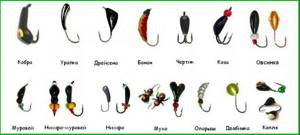
Mormyshka is an excellent bait. It is usually used in two forms: without an attachment or with an attachment on a bloodworm hook. The bloodworm bait is useful in catching perch in winter, because the fish may not rush to the jig without the bait.
At the same time, the external characteristics of the jig (shape, color) do not play a primary role, but it is very important to choose a jig with the correct weight and a comfortable size. It is also necessary to evaluate and check the hook - it is good if it is sharp and of medium size.
Using a jig with an attachment, you just need to take a couple of bloodworms, this number is enough to catch perch. It’s also great to feed the hole immediately before fishing, especially if the hole is not deep. Tactics and movement play an important role in fishing with a jig.
Often, perch bite in good numbers only thanks to the tempting game of the jig. We remember the pauses during the moments of playing with a jig, 15-20 seconds, and at this moment the main bites of the perch may occur. And if you lower it to the bottom and play, forming a cloudy cloud, the perch may decide that there are small fish or bugs in this ball, and a predator will start talking in it.
Catching perch on the first ice with a jig is perfect for anglers who are just starting out in this hobby.
Fishing tactics
First, the first ice covers small ponds, oxbow lakes and small slow-flowing rivers. You can start chasing the striped robber in such water areas, as well as on the edges of large bodies of water, if you can walk on ice in such places and swim without danger. Fortunately, in many places, perch in the first ice often stays close to the shore, near coastal thickets and relief anomalies.
Many subglaciers practice a universal approach - they try to catch perch both with spoons with balancers and with jigs, baited or reelless. Others are fans of a certain fishing method. The tactics for catching perch on the first ice using a jig, with or without bloodworms, as well as lures, are approximately the same. This means drilling into promising areas and moving frequently, fishing as much water area as possible.
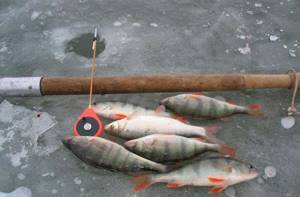
The first hole is usually drilled closer to the shore, at the top point of the dump or at the edge of reeds, reeds, and kugi. Then we move perpendicular to the shore, looking for the depth level at which the perch is held. With experience, anglers develop a sense that this is where they need to drill.
In small bodies of water, the drilling scheme directly depends on the surrounding topography. Here it is better not to drill everything in a checkerboard pattern, but to deliberately check the most promising areas using external landmarks.
About catching perch with baitless jigs on the first ice is described in more detail in the article provided at the link. Here we will dwell in more detail on the classic bait jig, and consider the nuances of this particular method of fishing.
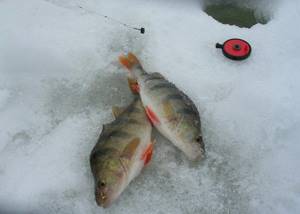
Search for operating points
First of all, on the first ice we look for perch with jigs on the standard favorite striped places:
- Snags, flooded logs and fallen trees, protruding bushes.
- Thickets of aquatic vegetation, in windows or along the edge.
- Dump into a hole from a solid wall of reeds with a depth of 1-3 meters.
- Local disturbances of the relief - holes, spits, turns of the channel.
- Entrances and exits from pits, recesses before and after rapids.
- Pools under the bank with overhanging bushes.
- Flooded piles, platforms, pillars.
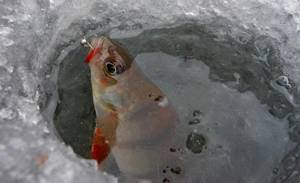
On large bodies of water there are no external landmarks; here we base our search on depth measurements. It’s better, of course, if the body of water is familiar and all underwater anomalies are known. We are looking as usual - on underwater spits and navels, exits from pits, edges. In reservoirs with lunar relief, we systematically fish squares of the water area in a checkerboard pattern.
There is no need to go straight into the depths unless we are primarily hunting for humpback salmon at pike perch points, when we know in advance that perch is present here. More attention should be paid to the shallower water zone, where the fry and other living creatures, the food supply for perch, are kept.
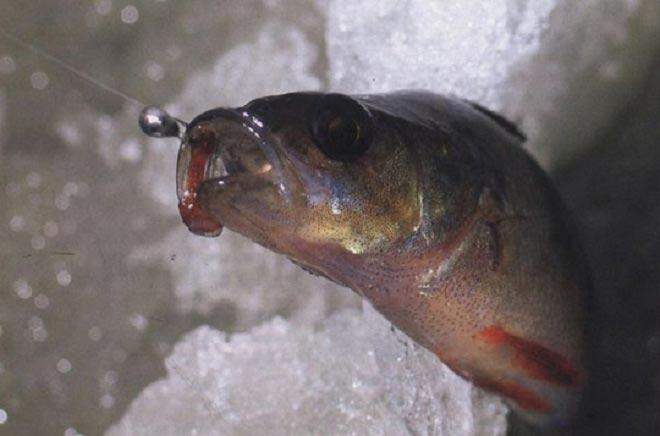
Bait on the first ice
In reservoirs with a large population of striped pirates, it is also possible to catch them using bait. In the case of catching perch on the first ice with a jig, bait is needed rather because of lazy motives - so as not to walk, but to collect an active predator at one point. This is a matter of experiment - it works on some reservoirs, not on others.
- First, the striped one still needs to be found in principle. If you caught several fish in a certain square, you can switch to stationary fishing, luring the perch to the point. This strategy will only work when the perch is actively moving - otherwise it simply will not approach the hole.
- The essence of the method is to create a constant boil under the hole. It is not even necessary to use bloodworms - you can lure small things with vegetable bait - perch will also do well, attracted by the activity of leucorrhoea. However, after approaching the little things, stake out at the perch point. To do this, we periodically send a small portion of bloodworms into the hole.
- The perch will most likely disperse the whitewash and stand on the spot itself, devouring the falling larvae. And here it’s just in place - a jig with bloodworms descending in the falling bait column. We form an artificial mini-cauldron, provoke and attract the tabby from all over the area. Active perch will gather from a radius of several tens of meters. The most important thing here is to keep the predator interested all the time - otherwise the active fish will move on in search of food.
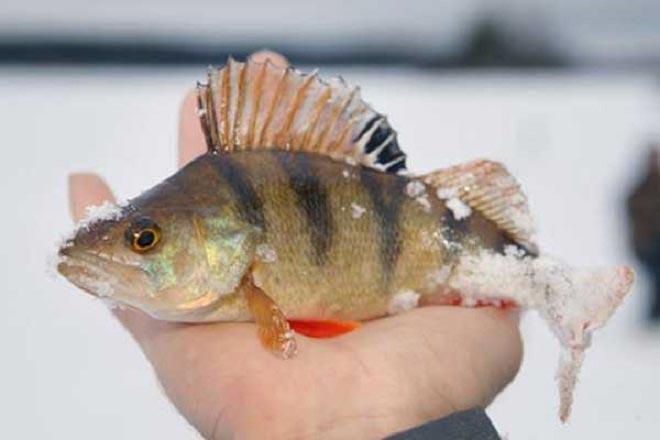
Nozzles
The standard attachment for fishing for perch with a jig on the first ice is a bloodworm or a jig, depending on the reservoir. Mormysh works where there are few bloodworms, and this crustacean is the basis of the food supply. For active biting we plant 2-3 larvae (crustaceans), and for passive biting - one. In addition, you can attach the following to the jig:
- Worm pieces;
- Maggot;
- Bark beetle larva;
- Chernobyl larva;
- The eye of a previously caught perch or a piece of meat with a fin.
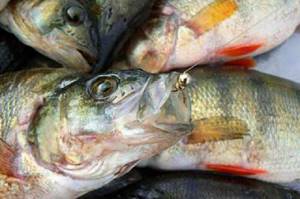
What to feed perch
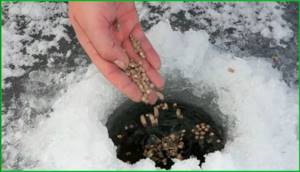
In winter, complementary feeding for fish is not complicated and is mainly done with your own hands, or bought at any pet store. Most often, they buy (or make their own preparations in advance) small bloodworms and use them not only as a bait for a jig, but also by throwing them into the hole in small quantities. In addition to bloodworms, you can buy (or make preparations from the summer) a worm, dung or earthen, chopped into small pieces.
Small pieces of mussels, which can be prepared at home, also attract the attention of perch quite well.
In addition to such animal complementary foods, in winter you can also choose the following options: breadcrumbs, cake or bran. They perfectly attract the attention of fish and activate its activity. They are also thrown in small quantities directly into the hole, forming a turbidity to which not only small fish are attracted, but also striped hunters. This method can definitely be considered when the perch is inactive and a jig is used as bait.
Which bait to choose on the first ice
There are no universal and best baits. Each of them is good in certain conditions, also depending on the mood of the perch. You must have a set with you, with the maximum selection of spinners, jigs and balancers. In search of the most catchy one, today you can go through more than a dozen models. Below we will consider the techniques and principles of each of them in particular.
Mothless
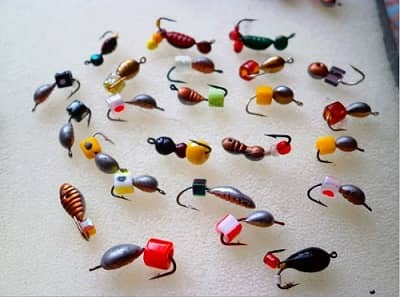
A reelless jig is a jig (devil, goat and others), without the use of a nozzle. Today one of the most popular ice lures. It is convenient because it does not require maggots or bloodworms. With a rewinder, it is possible to use additional irritants on the hook, such as beads, beads or rubber casings.
Red, yellow, and white colors work well for perch, acting as an attack point. A fishing rod 20 cm long, with a fishing line of 0.1-0.14 mm will be just right. It is imperative to use a soft nod, bending 30-40 degrees under the weight of the rewinder. This tackle is universal, working on both predatory and peaceful fish: bream, roach and others.
Mormyshka with nozzle
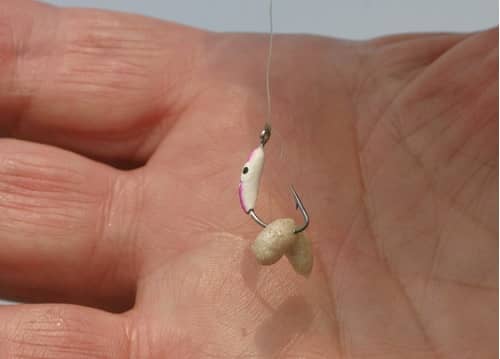
The only difference with a reelless jig is that bait is additionally attached to the jig. Its role can be played by: a worm, bloodworm, maggot. The number of baits varies depending on the preferences of the fish on a particular day, usually it is 1-2 bloodworms or oparika.
Before going fishing you need to buy all this. Accordingly, the method is more labor- and time-consuming, requiring additional preparation. For the sake of fairness, it is worth noting that sometimes only the jig works, and everything else is silent.
Spoons and balancers
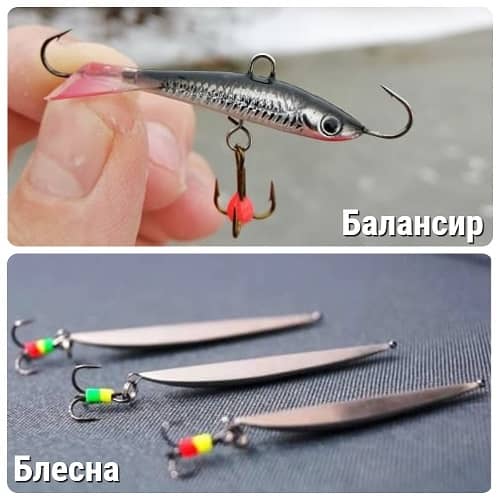
Balancers have a large range of motion, creating serious vibrations. The latter, in turn, attract perch from a long distance. Experienced fishermen, for reconnaissance purposes, use balancers or spinners with a sweeping action. When the fish is attracted and stands under the hole, throw a vertical jig or a reelless bait.
The size of the bait does not exceed 4-5 cm. Cord is not used in ice fishing. It is difficult to remove frozen ice from it, and it also floats a lot.
When the wind blows it away and clinging to the edges of the hole, the action of the bait is disrupted. Whether or not to use a nod is a choice for each individual angler. If present, it should be moderately hard, capable of responding to bites. At the same time, after stopping the bait under water, it should not hesitate.
Basic Wiring Methods
Wiring is a creative process. Experiment with speed, frequency, pauses. The task is to provoke the perch to attack by finding the key to its mood. Remember at what depth the fish is located so as not to waste time searching again.
- Gently shake the bait while raising and lowering the tackle.
- Rising half a meter from the bottom and slowly lowering until it touches it.
- Rocking with lifting. By swinging, we raise the tackle 15 cm from the bottom, then lower it by 10 cm with the same swing. All layers of water are fished using this method.
As a conclusion, we note that on first ice it is possible to use any bait. Be sure to have as many varieties of them with you as possible, this will help you find the best one for today. Everything else comes with experience, don’t be afraid to experiment.
How to catch a large perch on the first ice
So - to consolidate, catching perch on the first ice is always active, regardless of the use of different types of gear. The tactics are almost the same everywhere:
- We drill from five to twenty holes according to a special pattern, starting from the shore of the reservoir.
- We use complementary foods, any of the convenient options that we discussed earlier.
- We check the holes with gear.
- When the bite comes, we continue fishing and catching perches until it ends, after which we can change our location.
- It definitely wouldn’t be superfluous to use a hole swing for any type of striped fish catch: be it a spinner, a balancer or a jig.
- Playing with bait directly depends on the chosen fishing method.
- The fisherman himself chooses the method he will use for winter fishing, because a lot depends on the preferences of the perch species in different bodies of water.
Tackle that will definitely be useful for catching perch on the first ice:
- Flashing;
- Mormyshka with nozzle;
- Mothless;
- A simple fishing rod with bait.
Suitable tackle
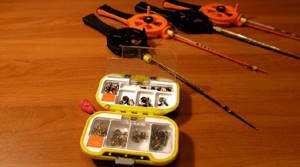
On the first ice, along with a balance beam and a bottom spoon, perch is actively caught using reelless and attached jigs
Reelless fishing
To catch perch on the first ice, use the following reelless jigs:
- "Witch";
- "Devil";
- "Uralka" (Ural)
- "Klopik";
- "Ant";
- "Goat".
The fishing rod used in this type of gear is a reelless “puck” fishing rod or an ordinary balalaika with a short whip. They equip it with 10-15 meters of thin monofilament line with a cross-section of 0.08 mm, and a gentle lavsan nod 10-12 cm long.
Recommended reading: How to catch crucian carp in winter from ice
The fishing technique for this bait is as follows:
- The bait is carefully lowered into the hole;
- While releasing the line from the reel, wait until the jig sinks to the bottom. The moment the bait touches the bottom is determined by straightening the nod.
- Raising the bait 2-3 cm above the bottom, sharply lower it back. This technique (“knocking on the bottom”) allows you to create turbidity at the place where the bait falls, which attracts fish.
- After several hits on the bottom, the rod is placed flat and the jig begins to oscillate at various frequencies.
- Playing with the jig is performed simultaneously with its lifting. Sometimes when playing with bait, short pauses lasting 1-2 seconds are made. They are done on average every 0.5-0.6 meters of ascent.
- At the end of the wiring, a short control sweep must be performed.
Important. When fishing at shallow depths, the hole is not cleared of sludge. To lower the bait under water, make a small hole in the ice crumble with a stick. This technique allows you not to expose the hole and not scare away the fish from it.
If high-frequency play does not produce results, it is replaced with a smoother low-frequency one. However, as noted, low-frequency vibrations do not attract perch. Therefore, if there were no bites for a quick game, after performing several short low-frequency ones, move on to the next hole.
Using a jig with a nozzle
In addition to reelless jigs, the following models of bait jigs are actively used in perch fishing:
- "A drop";
- "Cobra";
- "Pellet";
- "Ovsinka";
- "Banana";
- "Poker".
Bloodworms, burdock or jigs are used as bait for such jigs. Less commonly used for such baits are artificial bloodworms and small red maggots.
For fishing with attached jigs, balalaika-type fishing rods are used. Their equipment consists of a 10-meter supply of monofilament with a thickness of 0.10-0.12 mm. The nods of such jig tackle are varied - from flexible lavsan to hard metal.
The technique of playing with bait baits at this time is less aggressive than with reelless baits. As a rule, when playing with attached jigs, fluctuations of medium amplitude alternate with pauses every 30-40 cm of lift. Under some weather conditions, reverse wiring gives good results. Its essence is to lower the bait with simultaneous high-frequency oscillations.
Recommended reading: When do burbot spawn?
On a note. To attract fish when fishing with heavy jigs, a balancing game often works. For this purpose, the bait is not animated by oscillations of various frequencies, but is abruptly thrown 15-20 cm above the bottom.

